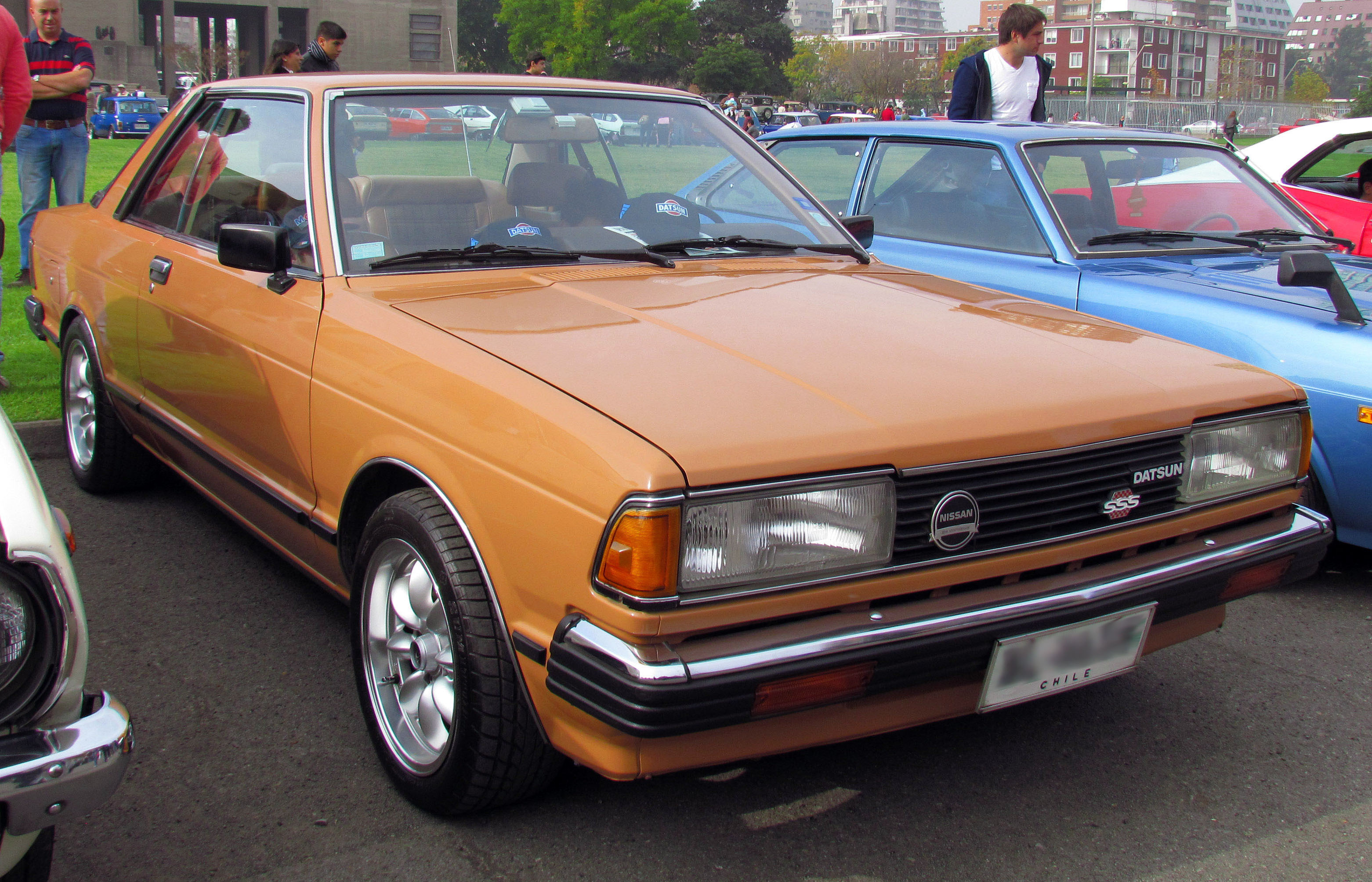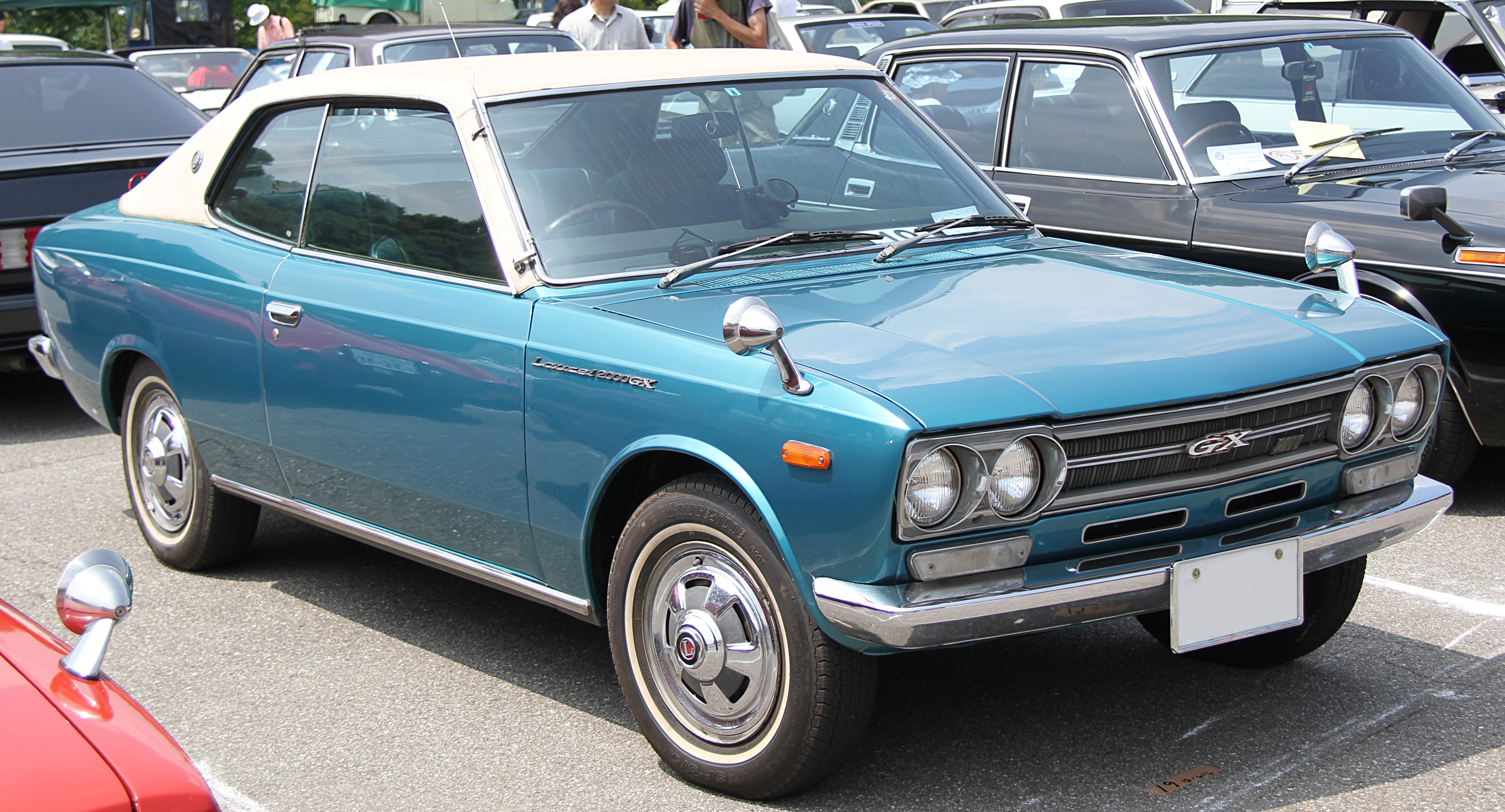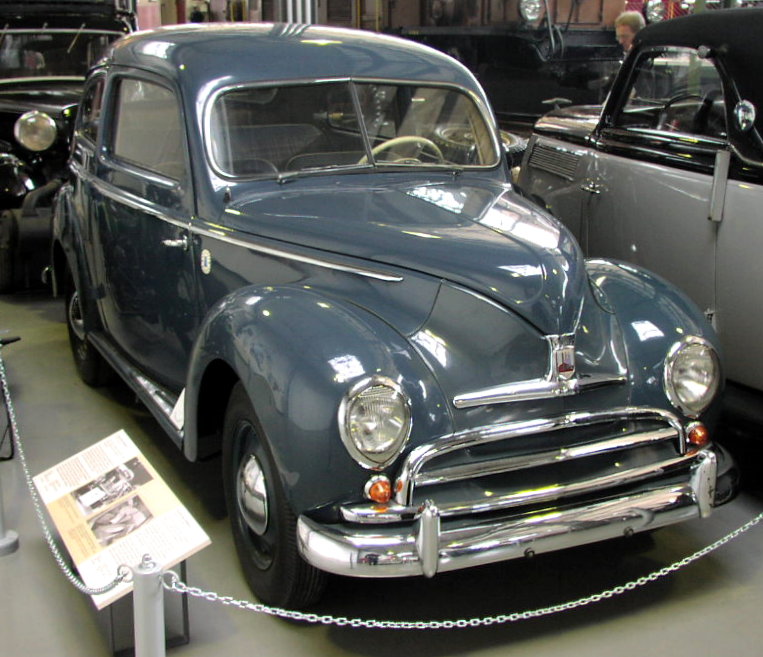|
Datsun Bluebird 910
The Datsun Bluebird (910) is an automobile which was produced by Nissan from 1979 to 1984. Nissan began realigning its export names with its home market names with the 910 series in November 1979. The 'B' tags were dropped in favour of 'Bluebird', though the models were marketed as 'Datsun Bluebird' initially. The Bluebird 910, which was the last rear-wheel drive Bluebird, featured simple clean-cut squared-off lines, unlike the "Coke Bottle" styling of its predecessor.Martin Lewis, A-Z of Cars of the 1980s, 1994, page 102 It did however retain the same engine range, the same MacPherson strut suspension and the same wheelbase as the 810. It went on sale in Europe over the summer of 1980, where its main competitors were traditional rear-wheel drive saloons including the Ford Taunus/Cortina and Opel Ascona/Vauxhall Cavalier. It also had a number of front-wheel drive rivals, including the Peugeot 305 and Renault 18. Nissan had enjoyed significant sales success in Britain since the ... [...More Info...] [...Related Items...] OR: [Wikipedia] [Google] [Baidu] |
Yulon Motor
Yulon Motor Co., Ltd. () is a Taiwanese automaker and importer. Taiwan's biggest automaker as of 2010, Yulon is known for building Nissan models under license. The original romanization of the company's name is Yue Loong, but in 1992 the company renewed its logo and switched to the shorter ''Yulon'' name. Historically, it is one of Taiwan's "big four" automakers. The company has over time evolved as a holding company that encompassed multiple public entities such as Yulon-Nissan Motor, Yulon Financial, Yulon Rental, Carnival Industrial Corporation and others. The group currently has a rivalry with Hotai Motor Group as the two largest Taiwanese automotive companies. Yulon created a new brand to sell self-designed cars, Luxgen, in 2010. As of 2017 it had a Revenue of NT$99 billion (US$3.4 billion) and about 12,680 employees. History Incorporated in September 1953 as a machinery company by Ching-Ling Yen, today Yulon Motor Co., Ltd. is part of the Yulon Group, a Taiwane ... [...More Info...] [...Related Items...] OR: [Wikipedia] [Google] [Baidu] |
Nissan CA Engine
The CA engine is a series of Inline-4 piston engines from Nissan. It is designed for a wide variety of smaller Nissan vehicles to replace the Z engine and some smaller, four-cylinder L series engines. The "CA" stands for Clean Air, due to the installation of Nissan emission reducing technology, called NAPS-X. The CA is an iron block, aluminum head design with a timing belt, cheaper to make than the timing chain setup on the Z and L engines. Earlier versions featured SOHC and eight valves. The new CA block design was a scaled-up E series block with timing shaft and other ancillaries removed. The oil pump is fitted directly onto the crank nose and the distributor is driven by the end of the camshaft. Like the E series and the A block from which the E was derived, Nissan used a taller block for the largest stroked 2.0-litre engine. The CA was designed to be compact and light, with a CA16 requiring only of space (compared to for the earlier Z16), while weighing 23% less at ... [...More Info...] [...Related Items...] OR: [Wikipedia] [Google] [Baidu] |
Complete Knock Down
A knock-down kit (also knockdown kit, knocked-down kit, or simply knockdown or KD) is a collection of parts required to assemble a product. The parts are typically manufactured in one country or region, then exported to another country or region for final assembly. A common form of knock-down is a complete knock-down (CKD), which is a kit of entirely unassembled parts of a product. It is also a method of supplying parts to a market, particularly in shipping to foreign nations, and serves as a way of counting or pricing. CKD is a common practice in the automotive, bus, heavy truck, and rail vehicle industries, as well as electronics, furniture and other products. Businesses sell knocked-down kits to their foreign affiliates or licensees for various reasons, including the avoidance of import taxes, to receive tax preferences for providing local manufacturing jobs, or even to be considered as a bidder at all (for example, in public transport projects with "buy national" rules). ... [...More Info...] [...Related Items...] OR: [Wikipedia] [Google] [Baidu] |
1982 Datsun Bluebird 1
__NOTOC__ Year 198 (CXCVIII) was a common year starting on Sunday (link will display the full calendar) of the Julian calendar. At the time, it was known as the Year of the Consulship of Sergius and Gallus (or, less frequently, year 951 '' Ab urbe condita''). The denomination 198 for this year has been used since the early medieval period, when the Anno Domini calendar era became the prevalent method in Europe for naming years. Events By place Roman Empire *January 28 **Publius Septimius Geta, son of Septimius Severus, receives the title of Caesar. **Caracalla, son of Septimius Severus, is given the title of Augustus. China *Winter – Battle of Xiapi: The allied armies led by Cao Cao and Liu Bei defeat Lü Bu; afterward Cao Cao has him executed. By topic Religion * Marcus I succeeds Olympianus as Patriarch of Constantinople (until 211). Births * Lu Kai (or Jingfeng), Chinese official and general (d. 269) * Quan Cong, Chinese general and advisor (d. ... [...More Info...] [...Related Items...] OR: [Wikipedia] [Google] [Baidu] |
Nissan Laurel
The Nissan Laurel is a front-engine, rear-drive two- and four-door sedan manufactured and marketed by Nissan from 1969 to 2002. Introduced in 1968 as a new model positioned above the 1968 Datsun Bluebird 510, the Laurel offered the luxury of the Nissan Cedric 130 in a smaller size. In Japan, the Laurel was marketed soley as a Nissan model, rather than a Datsun model. The first Laurel was developed by the Nissan Tsurumi R&D Division and assembled at the Musashimurayama Plant of the former Prince Motor Company in 2-door and 4-door variants. Released as a Nissan after Prince merged with Nissan, Laurels shared many components and architectures with the Skyline range. The Laurel was not marketed new in Japan at ''Nissan Prince Shop'' locations that sold the Skyline and Gloria, former Prince products. Instead the Laurel was sold at '' Nissan Motor Shop'' as the junior model to the larger V8-powered Nissan President. Since 1968, eight generations of Laurel have been manufactured i ... [...More Info...] [...Related Items...] OR: [Wikipedia] [Google] [Baidu] |
Nissan Violet
The Nissan Violet is a model of car that appeared in Japan in 1973, and was exclusive to Japanese Nissan dealerships called ''Nissan Cherry Store '' as a larger companion to the Nissan Cherry. In 1977 the second generation arrived. This was split into two additional lines, the Nissan Auster and the Nissan Stanza. All three models bore the A10 series identifier, and were built in Japan at the Hiratsuka and Yokosuka assembly plants. The Stanza was exclusive to Japanese Nissan dealerships called ''Nissan Satio Store'' as a larger companion to the smaller Nissan Sunny, and the Auster triplet was exclusive to ''Nissan Prince Store'' locations as a larger companion to the Nissan Langley. A new third generation front-wheel drive model was launched in 1981, changing the series name again to T11, and sharing its platform with the Compact MPV Nissan Prairie/Multi/Stanza Wagon. Final versions were Nissan Bluebirds series U12 rebadged for some international markets. In most export marke ... [...More Info...] [...Related Items...] OR: [Wikipedia] [Google] [Baidu] |
Renault 18
The Renault 18 is a large family car produced by French manufacturer Renault between 1978 and 1989, with South American production continuing until 1994. It formed the basis for the closely related Renault Fuego Coupé, with which it shared its floorpan and drivetrain, but with the Fuego initially using the negative offset type front suspension from the larger Renault 20/30, which became standardized across the 18 range from the 1983 model year onwards. Development The Renault 18 was intended as a replacement for the Renault 12, which, having been in production since 1969, was beginning to show its age by the late 1970s, though the 12 was kept in production alongside the 18 until 1980. Unlike the earlier car, the 18 was designed quickly; the time between its initial conception and its actual launch date was only eighteen months, primarily due to the fact that the 18 was based upon the 12's underpinnings. Production peaked early: 1979 was the R18's biggest year, after which sales ... [...More Info...] [...Related Items...] OR: [Wikipedia] [Google] [Baidu] |
Peugeot 305
The Peugeot 305 is a medium-sized car produced by the French automaker Peugeot from 1977 to 1989. It was offered as a four-door saloon, five-door estate, and as a three-door van body derivative. History Origins During the mid 1970s, the motoring press speculated that a new Peugeot would soon arrive, in order to update the company's model lineup, in an attempt to make the Peugeot more internationally appealing. Since Peugeot had only recently discontinued their long-running 404 model, many people thought that the purpose of the new car would to fill the gap, previously occupied by the 404, between the 304 and 504 models, to compete against cars like the Ford Cortina/ Taunus and Renault 12. It therefore would have been natural for the new car to be called the 405, commencing a new "05" generation of Peugeot models. The car was to be developed from and use the running gear from the smaller 304, but in terms of size and price, it was to succeed the already-defunct 404, especially con ... [...More Info...] [...Related Items...] OR: [Wikipedia] [Google] [Baidu] |
Vauxhall Cavalier
The Vauxhall Cavalier was a large family car that was sold primarily in the UK by Vauxhall from 1975 to 1995. It was based on a succession of Opel designs throughout its production life, during which it was built in three incarnations. The first generation of Cavalier, launched in 1975 and produced until 1981, was based on the existing Opel Ascona and Opel Manta with a few minor visual differences. The second generation of Cavalier, launched in 1981 and produced until 1988, was launched simultaneously with the identical new generation of Opel Ascona, which was sold across the world in various guises on the General Motors " J-car". The third and final generation of Cavalier, launched in 1988 and produced until 1995, was based on the first generation of Opel Vectra with the same production span. __TOC__ Mark I (1975–1981) Launched with a 1,896 cc engine as a 1976 model in November 1975, the Cavalier was a restyled version of the second generation German Opel Ascon ... [...More Info...] [...Related Items...] OR: [Wikipedia] [Google] [Baidu] |
Opel Ascona
The Opel Ascona is a large family car (D-segment in Europe) that was produced by the German automaker Opel from 1970 to 1988. It was produced in three separate generations, beginning with rear-wheel-drive and ending up as a front-wheel drive J-car derivative. The Ascona took its name from the lakeside resort of that name in Ticino, Switzerland, and already in the 1950s a special edition of the Opel Rekord P1 was sold as an Opel Ascona in Switzerland, where the name was again used in 1968 for a locally adapted version of the Opel Kadett B into which the manufacturers had persuaded a 1.7-litre engine borrowed from the larger Rekord model of the time. The Opel Ascona A launched in 1970 and sold across Europe was, however, the first mainstream Opel model to carry the name. The Ascona was introduced in September 1970, lasting for 18 years and 3 generations and ended production in August 1988, to be replaced by the Opel Vectra A. In motorsport, Walter Röhrl won the 1982 World Ral ... [...More Info...] [...Related Items...] OR: [Wikipedia] [Google] [Baidu] |
Ford Cortina
The Ford Cortina is a medium-sized family car that was built initially by Ford of Britain, and then Ford of Europe in various guises from 1962 to 1982, and was the United Kingdom's best-selling car of the 1970s. The Cortina was produced in five generations (Mark I through to Mark V, although officially the last one was only the Cortina 80 facelift of the Mk IV) from 1962 until 1982. From 1970 onward, it was almost identical to the German-market Ford Taunus (being built on the same platform), which was originally a different car model. This was part of Ford's attempt to unify its European operations. By 1976, when the revised Taunus was launched, the Cortina was identical. The new Taunus/Cortina used the doors and some panels from the 1970 Taunus. It was replaced in 1982 by the Ford Sierra. In Asia and Australasia, it was replaced by the Mazda 626-based Ford Telstar, though Ford New Zealand did import British-made complete knock-down kits of the Sierra estate for local assemb ... [...More Info...] [...Related Items...] OR: [Wikipedia] [Google] [Baidu] |
Ford Taunus
The Ford Taunus is a family car that was sold by Ford Germany throughout Europe. Models from 1970 onward were built on the same basic construction as the Ford Cortina MkIII in the United Kingdom, and later on, the two car models were essentially the same, differing almost only in the placement of the steering wheel. The model line was named after the Taunus mountain range in Germany, and was first made in 1939, and continued through several versions until 1994. Taunus G93A (1939–1942) / G73A (1948–1952) The Ford Taunus G93A was a development of the Ford Eifel, and used the same 1172-cc four cylinder engine, but in a longer chassis and a streamlined body. It was the first German Ford to have hydraulic brakes. Due to the war, production was interrupted from 1942 to 1948; 7,128 were made, including estate cars and light vans. Taunus M-series (1952–1968) From 1952 to 1968, all German Fords were called the Taunus, using the model names 12M, 15M, 17M, 20M, and 26M (on some ... [...More Info...] [...Related Items...] OR: [Wikipedia] [Google] [Baidu] |






_en_Espagne.jpg)
.jpg)
.jpg)

